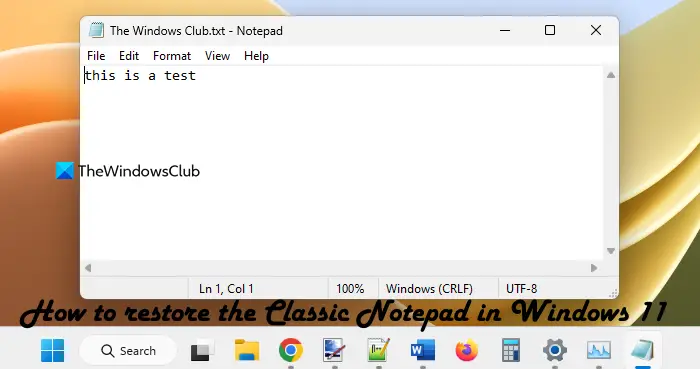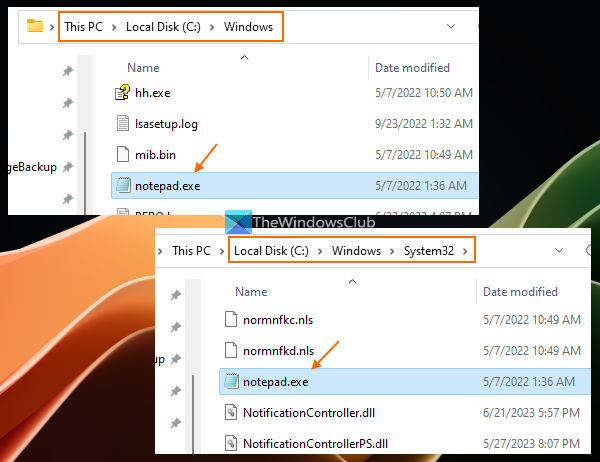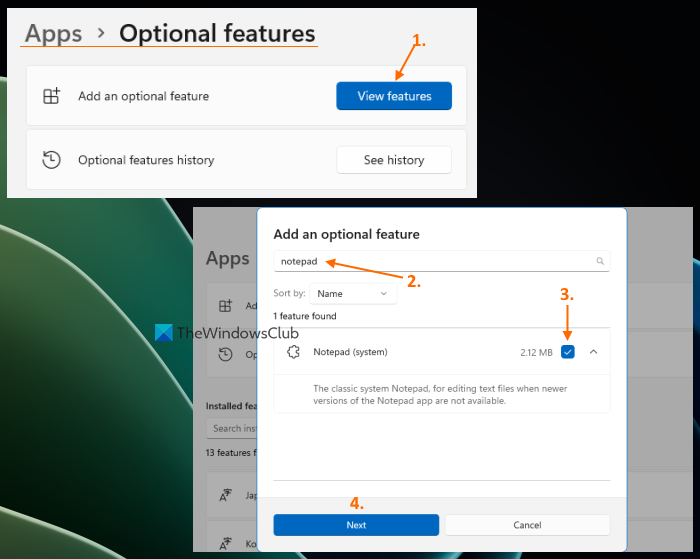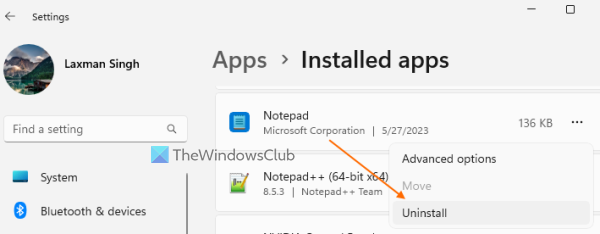The new UWP Notepad app has replaced the old legacy Notepad in Windows 11. The redesigned Notepad for Windows 11 has some good features such as the tabbed interface to open multiple tabs in a single window and work with different text files, switch to dark mode, improved find and replace capability, etc. However, some users miss that classic and simple text editor to edit or view plain text files. Thankfully, there are some simple ways to restore the Classic Notepad in Windows 11, and this post includes all such ways.

How to restore the Classic Notepad in Windows 11
Here are the native options to restore the Classic Notepad in Windows 11:
- Open the Classic Notepad from its stored locations
- Install the Classic Notepad using Optional features in the Settings app
- Uninstall the new Notepad app.
Let’s check all these options in detail.
1] Open the Classic Notepad from its stored locations

This is the simplest and one of the best options to restore the classic Notepad in Windows 11. Even though the new Notepad app has replaced the old Notepad application, its notepad.exe file is still there in the original location(s). So, you can access those locations and then open the classic Notepad. The paths for the classic Notepad EXE files are:
- C:\Windows\notepad.exe
- C:\Windows\System32\notepad.exe
Access any of these two locations and execute the notepad.exe file. The classic Notepad will open immediately. Once it is opened, you can pin it to the taskbar so that you can open it anytime with a single mouse click.
Alternatively, you can also open the Run Command box (Win+R), type notepad.exe, and hit Enter to open the classic Notepad in Windows 11. But this will only work if the EXE files for the old Notepad are present in your system.
Read: How to change Notepad Font and Size in Windows 11
2] Install the Classic Notepad using Optional features in the Settings app

If the above option doesn’t work and notepad.exe files are missing from your Windows 11 system, then you can install Classic Notepad using the Optional features of Windows 11. For this, use the following steps:
- Press the Win+I hotkey to open the Settings app of Windows 11
- Select the Apps category
- Access the Optional features page
- Click on the View features button available just next to Add an optional feature
- A box will appear. There, type notepad in the search field
- Select the checkbox for Notepad (system)
- Press the Next button
- Press the Install button.
Wait until the installation process is finished. After that, you might need to restart your PC. Once done, the notepad.exe file for the classic Notepad will be stored in the Windows folder and the System32 folder in the C drive. From there, you can execute the executable file and the old Notepad application will open.
3] Uninstall the new Notepad app

If you don’t like the new Notepad app and want to keep using the classic Notepad only in Windows 11, then simply uninstall the new Notepad app. For this:
- Open the Settings app using the Win+I shortcut
- Click on the Apps category from the left section
- Access the Installed apps section
- Click on the three horizontal dots icon available for the Notepad app
- Select the Uninstall option
- Confirm your action by pressing the Uninstall button in the given pop-up.
Now when you will double-click on a text file, it will open with the classic Notepad automatically. Or else, you can manually set classic Notepad as the default application to open the text files.
I hope this helps.
NOTE: Please read the comment by Peter below.
Where is Notepad EXE in Windows 11?
The Notepad.exe file for the Notepad app is stored in the following location on Windows 11:
C:\Program Files\WindowsApps\Microsoft.WindowsNotepad_11.2304.26.0_x64__8wekyb3d8bbwe\Notepad
First, you must show hidden files and folders on your Windows 11 system because the WindowsApps folder remains hidden by default. Also, the version number for the Notepad app folder could be different depending on the installed version on your system.
Why is Notepad not showing up in Windows 11?
If you have installed classic Notepad but Notepad is not opening or showing on your Windows 11 system, then you can run its EXE file from the main folder (System32 or Windows folder). If that doesn’t help, first uninstall and then re-install Notepad using the Settings app of Windows 11. You may also need to troubleshoot in the Clean Boot state to find the conflicting applications and then remove/disable such items.
Read next: Best free Note taking apps for Windows PC.